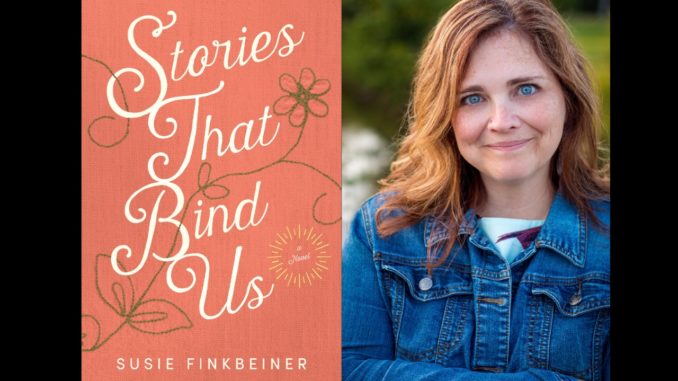
Podcast: Play in new window | Download
Subscribe: Apple Podcasts | RSS
There’s great power in a good story. Stories bring us together, help us find common ground, take us on a common journey. In Stories That Bind Us, Susie Finkbeiner weaves a compelling relational narrative about the lives of various people and their intersection. Often, fiction writers take the liberties of fiction to push stories to the upper limits of credulity. Suspense, thrillers, mysteries, and such do this in a way that provides escapism from life-as-normal. Romance, too, often stretches the imagination to entertain, thrill, or titillate.
There’s something comforting in the type of novel that simply presents life as it is, full of its own type of loves, losses, and surprises, and reminds us that these stories—so often the stories of our lives—as also worth telling. Stories That Bind Us is ostensibly about Betty Sweet, who builds a relationship with her five-year-old nephew soon after her husband’s death and her sister’s institutionalization, but it’s also so much more.
The Interview | Susie Finkbeiner
This excerpt has been lightly edited for brevity and clarity. You can listen to the full interview by clicking the play button above or subscribing at Apple Podcasts, Stitcher, Spotify, or wherever you listen to podcasts.
Josh Olds: I said in my review that the power of Stories That Bind Us is that there’s nothing spectacular about it. And usually when you say that about a novel, it’s not a compliment. But for me, this is a compliment in that you are showing that just the power of an ordinary life is a story worth telling. And that really struck me. So when you’re when you’re writing this story, did you ever feel like, “Oh, this isn’t enough, people are gonna want me to spice it up a bit.”
Susie Finkbeiner: You know, that can be a temptation. But I knew that the power of the story would rest on the everyday. This could be anyone’s life and I’m inviting the reader into that. For me, if I’m inviting someone over to my house, I want them to get a glimpse of what our normal life is and so having things not be sensationalized is important to me.
 Josh Olds: the story is set, I think, in the 1960s, in Michigan, and Hugo is biracial. And I feel like that component alone could probably have driven the entire novel. Was that element in it from the beginning?
Josh Olds: the story is set, I think, in the 1960s, in Michigan, and Hugo is biracial. And I feel like that component alone could probably have driven the entire novel. Was that element in it from the beginning?
Susie Finkbeiner: As soon as I pictured Hugo in my mind, he was biracial. And I didn’t know why, but I went with it. I think that that sometimes when we have an instinct in storytelling, we need to follow that instinct, and see where it takes us. And I think that at that time, it was extremely difficult for someone who is biracial, or a person of color. It’s always been so, so difficult and so many obstacles set in front of people of color. And I really wanted to highlight not only, you know—I can never imagine what it was like—but I can imagine what Betty would be processing, in finally getting to know someone who has a different skin tone, and loving him so desperately and wanting such good things for him. And that will open our eyes to what’s going on in the world.
I think that when, like Betty was before, when we’re kind of in a vacuum of people who are just like us, we don’t default to empathy. But when we can love someone who is oppressed, when we love someone who is experiencing things that we will never experience, that is eye opening to us. And I think that the country in the 1960s was awakening to that a little bit. And we’re not all the way woken up yet. But there is hope. You know, even in the past week, I’ve seen friends who are thinking, “Wait a second,” and they’re really diving in and trying to learn, and they’re listening to voices that they’ve never heard before. And that gives me so much hope.
The Book | Stories That Bind Us
Read the full Life is Story review.
Betty Sweet never expected to be a widow at 40. With so much life still in front of her, she tries to figure out what’s next. She couldn’t have imagined what God had in mind. When her estranged sister is committed to a sanitarium, Betty finds herself taking on the care of a 5-year-old nephew she never knew she had.
In 1960s LaFontaine, Michigan, they make an odd pair. Betty with her pink button nose and bouffant hair. Hugo with his light brown skin and large brown eyes. But more powerful than what makes them different is what they share: the heartache of an empty space in their lives. Slowly, they will learn to trust one another as they discover common ground and healing through the magic of storytelling.
Award-winning author Susie Finkbeiner offers fans a novel that invites us to rediscover the power of story to open the doors of our hearts.
The Author | Susie Finkbeiner
 Susie Finkbeiner is the CBA bestselling author of All Manner of Things, as well as A Cup of Dust, A Trail of Crumbs, and A Song of Home. She serves on the Fiction Readers Summit planning committee, volunteers her time at Ada Bible Church in Grand Rapids, Michigan, and speaks at retreats and women’s events across the country. Susie and her husband have three children and live in West Michigan.
Susie Finkbeiner is the CBA bestselling author of All Manner of Things, as well as A Cup of Dust, A Trail of Crumbs, and A Song of Home. She serves on the Fiction Readers Summit planning committee, volunteers her time at Ada Bible Church in Grand Rapids, Michigan, and speaks at retreats and women’s events across the country. Susie and her husband have three children and live in West Michigan.
